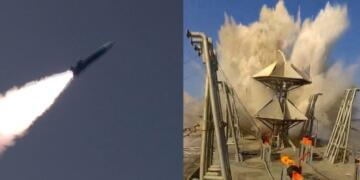In the past few days, “Operation Sindoor” has been in the news all the time. On April 22, terrorists murdered at least 26 individuals by shooting them in Pahalgam, Jammu and Kashmir. The terrorists questioned the victims about their religion before shooting them, and in a few instances, even forced people to undress. During the initial probe into the attack, it was revealed that the terrorists involved had direct connections with Pakistan. This terrorist attack had ignited the people of India with great anger and outrage. There were demands all around that this time around, firm and decisive action has to be taken against Pakistan.
To retaliate against the Pahalgam attack, India launched airstrikes against terrorism in Pakistan and Pakistan-occupied Jammu and Kashmir (PoJK) under “Operation Sindoor”. In this operation, India targeted and destroyed nine terrorist camps, deep within Pakistan, and sent across the world a strong message that its anti-terrorism policy is now firmer and more resolute. “Operation Sindoor” reaffirmed once again India’s military might, strategic prowess, and technological prowess. Let’s have a clear understanding in 9 important points what has India accomplished through this operation and what has been its overall impact.
Nine Terrorist Hideouts Destroyed
In “Operation Sindoor”, India completely destroyed nine high-value terrorist hideouts in Pakistan and PoJK. These included training and operational centers of notorious organizations like Lashkar-e-Taiba, Jaish-e-Mohammed, and Hizbul Mujahideen. Among the terrorist hideouts targeted, 4 were in Pakistan and 5 in PoJK. These places were key hubs for planning attacks against India. The Indian Army accurately identified and destroyed these terrorist launchpads, shattering the backbone of terrorism. This move demoralized the terrorists and completely derailed their future plans. The operation was an excellent example of India’s intelligence gathering, military planning, and technical capabilities. It proved that India is fully capable of taking decisive action against terrorism.

Striking Pakistan in Its Own Territory
“Operation Sindoor” changed the rules of warfare. India not only struck PoJK but also penetrated hundreds of kilometers inside Pakistan. Dangerous terrorist hubs like the military base in Punjab province and Bahawalpur were targeted — areas even the U.S. has hesitated to strike with drones. The message from Prime Minister Narendra Modi after the attack was not just about taking strict action against terrorists but also about punishing those who harbor them. India struck Pakistan inside its own home and made it clear that terrorists and their sponsors would be treated as one. This action sent a strong signal to Pakistan that Indians on the Indian soil will not be terrorized without consequences, and India’s response would not be confined by borders or the Line of Control. India demonstrated its military might and indomitable will, raising its profile on the global stage.
Tough Message to Global Terror Networks
This operation transformed India’s approach from retaliatory to decisive action. India killed at least 100 terrorists in the operation. “Operation Sindoor” drew a red line that Pakistan can no longer ignore. India made it clear that if terrorism is adopted as a part of state policy, the response will be swift, harsh, and visible to the world. This operation warned those elements in Pakistan who have long supported terrorism. India demonstrated that it is firmly committed to a zero-tolerance policy against terrorism. This red line is not just for Pakistan, but also for global terrorist networks, indicating that India can go to any lengths to protect its security. During this operation, India also made a crucial policy decision — any future terrorist act on Indian soil will be considered an act of war and will be responded to with full force.
Elimination of Key Terrorists
In “Operation Sindoor”, India eliminated several notorious terrorists.Some commanders of the terrorist cells were taken out on one single night. The terrorists had plans for various attacks on India and posed grave threats to national security. The operation harmed the leadership of the terror networks and brought major setbacks to the networks. In an all-party meeting held in India regarding the operation, the government informed that at least 100 terrorists were killed in attacks on their hideouts. According to sources, those killed included Abu Jundal, Hafiz Muhammad Jameel, Mohammad Yusuf Azhar, Mohammad Saleem, Ghosi Sahab, and Mohammad Hasan Khan. Mohammad Yusuf Azhar was the brother of Jaish-e-Mohammed chief Masood Azhar and was the mastermind of the Kandahar hijacking, while Jundal was involved in the Mumbai attacks. The coordinated action of India’s intelligence agencies and armed forces ensured that terrorists cannot escape India’s reach. This operation created fear among terrorists and further strengthened India’s fight against terrorism.
Pakistan’s Air Defense Exposed
The Indian Air Force totally disarmed Pakistan’s air defense system. The Rafale fighter planes made accurate attacks in just 25 minutes with SCALP missiles and HAMMER bombs with no casualties. This action exposed the vulnerability in the security setup of Pakistan. India successfully penetrated Pakistan’s Chinese-built HQ-9 air defense system, proving that buying weapons alone is not enough — proper deployment and usage matter.Air Marshal A.K. Bharti announced during a joint press conference of the three services on Sunday that India had bombed Pakistan’s air bases, headquarters, military installations, and air defense systems on the western front. The action was an exemplar of Indian technical and strategic superiority. The Indian Air Force’s success gave a new dimension to India’s military capability at the global level and exposed Pakistan’s defense system.
India’s Air Defense Demonstrated Power
In “Operation Sindoor”, India displayed its contemporary air defense prowess remarkably. Pakistan intensified aggression from Jammu and Kashmir to Punjab and Rajasthan. It used fighter aircraft, drones, and missiles against India. But Pakistan’s every effort went in vain before India’s speedy fighter aircraft and precise air defense system. Pakistan used Turkish-made Asisguard Songar drones. Some media reports even claimed that Pakistan launched a Fateh-II missile targeting Delhi, but India’s air defense system intercepted and destroyed it. Using systems like S-400, Barak-8, and Akash, India shattered Pakistan’s attacks. This system not only validated India’s defense capabilities but also established it as an export-worthy defense solution at the global level. India showed that its multi-layered defense system can successfully counter any threat. This operation brought India’s indigenous defense technology and military preparedness to the forefront, proving India is capable of dealing with any danger.
Crippled Pakistani Air Force
On the night of May 9 and 10, India attacked 11 Pakistani Air Force bases, including Noor Khan, Rafiqui, Murid, Sukkur, Sialkot, Pasrur, Chunian, Sargodha, Skardu, Bholari, and Jacobabad. According to an NDTV report, these strikes destroyed 20% of Pakistan’s air force infrastructure. At Bholari Airbase alone, more than 50 people, including Squadron Leader Usman Yusuf and several other military personnel, were killed. Many fighter aircraft were also destroyed. This action makes India the first country to strike the military bases of a nuclear-armed nation. These attacks dealt a severe blow to Pakistan’s military strength and demonstrated India’s military superiority.
Global Support and Shift in Kashmir Narrative
“Operation Sindoor” drew global attention to terrorism and earned India unprecedented support. Countries like Israel, Russia, and many others supported India. Earlier, India was often urged to show restraint against Pakistan, but this time many global leaders praised India’s anti-terror actions. This operation helped decouple India-Pakistan relations from the Kashmir issue and reframed it from a terrorism perspective. India proved through precise strikes that its fight is against terrorism, not a regional dispute. This narrative shift strengthened India’s position on the global stage and redefined the Kashmir issue in the context of counterterrorism. This was a diplomatic victory for India.
A Blunt Message to the World on Anti-Terrorism
With “Operation Sindoor”, India gave a strong and unequivocal message to the international community — it will not wait for anybody’s approval to safeguard its people. This move demonstrated that terrorism would be punished everywhere at any time, no matter how well concealed the terrorists or their handlers were. India not only demonstrated its military strength but also indicated that if Pakistan attempts to retaliate, India will not only defend itself strongly but also retaliate with even more strength if needed. This operation defined India’s zero-tolerance approach towards terrorism in the international community, projecting a better image of India as a confident and self-sufficient nation. This move is an intimation to the world terrorist network that no individual or organization is safe from India’s authority and determination.





























